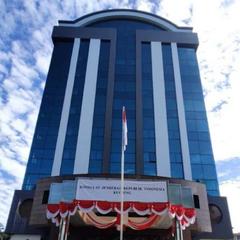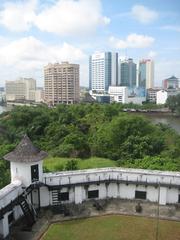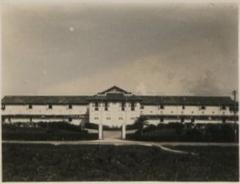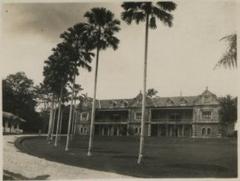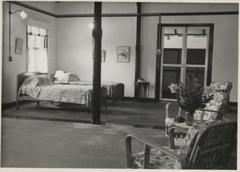Textile Museum Sarawak Visiting Hours, Tickets, and Guide to Kuching Historical Sites
Date: 04/07/2025
Introduction
Nestled in the heart of Kuching’s historic district, the Textile Museum Sarawak is a vibrant cultural landmark dedicated to preserving and celebrating the diverse textile heritage of Sarawak’s many ethnic communities. Housed in the iconic Pavilion Building—a colonial-era structure dating back to 1907—the museum stands as both a testament to Sarawak’s colonial past and a living showcase of indigenous artistry. This comprehensive guide covers everything you need to know for your visit: from Textile Museum Sarawak visiting hours and ticketing information to exhibition highlights, accessibility, and travel tips for exploring nearby Kuching historical sites. Whether you are a cultural enthusiast, textile aficionado, or a traveler seeking a deeper understanding of Malaysian Borneo’s traditions, the Textile Museum Sarawak offers an enriching and immersive experience. (Sarawak Tourism Board; Kuching Borneo Info; Sarawak Museum Department)
Table of Contents
- Introduction
- Historical and Architectural Context
- Sarawak’s Textile Heritage: Ethnic Traditions and Techniques
- Exhibition Highlights and Visitor Experience
- Museum Visiting Hours and Ticket Information
- Accessibility and Visitor Facilities
- Nearby Kuching Historical Sites
- Travel Tips for Visitors
- Frequently Asked Questions (FAQ)
- Conclusion
- References
Historical and Architectural Context
Colonial-Era Origins
The Textile Museum Sarawak occupies the Pavilion Building, an architectural treasure constructed in 1907 during the era of the White Rajahs. Initially serving as a medical center for government officers and their families, the building later became the headquarters of the State Education Department before being repurposed as a museum in 2000. The Pavilion Building’s Edwardian civic design—symmetrical facades, high ceilings, tall windows, and ornate ironwork—reflects Kuching’s historical evolution as a colonial administrative hub. (Sarawak Tourism Board; Sarawak Museum Department; Tourism Malaysia)
Conservation and Restoration
Careful restoration efforts have preserved original materials such as timber flooring and decorative plasterwork, ensuring that the Pavilion Building remains an authentic heritage site. Adaptive reuse principles guide ongoing maintenance, balancing historical integrity with modern safety and accessibility standards. (Sarawak Museum Department)
Sarawak’s Textile Heritage: Ethnic Traditions and Techniques
Ethnic Diversity and Textile Arts
Sarawak is home to over 40 sub-ethnic groups, each with distinct textile traditions. The museum’s collection features works from the Iban, Bidayuh, Malay, Orang Ulu, Penan, and the Chinese and Indian communities, highlighting the interconnectedness of Sarawak’s material culture. (Wikipedia: Culture of Sarawak)
Iban Pua Kumbu
The pua kumbu, a ceremonial cloth woven by Iban women, is internationally acclaimed for its intricate warp-ikat technique and symbolic motifs—birds, snakes, leeches, and human figures. These textiles play vital roles in rituals, ceremonies, and as grave shrouds, reflecting the cloth’s spiritual significance. (Sarawak Museum Department)
Malay Kain Songket
The kain songket, woven with gold or silver threads, is a symbol of aristocratic heritage in Malay communities. Traditionally reserved for special occasions, songket motifs are geometric and floral, with modern adaptations ensuring the craft’s continued relevance. (Sarawak Museum Department)
Bidayuh, Orang Ulu, and Penan Crafts
Bidayuh kesah mats and tambok baskets, Orang Ulu beadwork and ceremonial attire, and Penan bark cloth and woven items represent other key traditions. These crafts are not only utilitarian but also central to social status and ceremonial practices. (Wikipedia: Culture of Sarawak)
Exhibition Highlights and Visitor Experience
Exhibition Flow
The museum’s exhibitions are organized to trace the textile-making process—from raw fibers to finished garments. Informative panels, dioramas depicting traditional weddings, and hands-on “touch-on” exhibits provide context and enhance visitor engagement. (Kuching Borneo Info; Asian Itinerary)
Motifs, Meaning, and Social Function
Motifs such as animals, plants, and spirit figures are deeply symbolic, encoding stories, taboos, and cosmological beliefs. Textiles serve as markers of identity and status, with certain patterns reserved for specific ceremonies or social classes. (Sarawak Museum Department)
Contemporary Relevance
Modern designers and artisans are reinterpreting traditional motifs for contemporary fashion and home decor, ensuring the survival and dynamism of Sarawak’s textile heritage. The museum supports this through workshops, demonstrations, and collaborations with the Sarawak Craft Council. (Asian Itinerary)
Temporary Closure Notice
As of July 2025, the museum is temporarily closed for maintenance. Please check the Sarawak Museum Department website for reopening updates. (Sarawak Museum Department)
Museum Visiting Hours and Ticket Information
- Opening Hours:
- Monday to Friday: 9:00 AM – 4:45 PM
- Saturday, Sunday & Public Holidays: 10:00 AM – 4:00 PM
- Closed on select public holidays (e.g., Hari Raya, Gawai)
- Admission:
Entry is free for all visitors as part of the Sarawak Museum Department’s commitment to accessible cultural education. (Sarawak Government Service Portal)
Accessibility and Visitor Facilities
- Wheelchair Access: Partial (mainly ground floor); upper floors may require stair use.
- Restrooms: Available (adapted facilities may be limited).
- Gift Shop: Offers locally made textiles, crafts, and books.
- Information Desk: Staff can provide brochures and guided tour arrangements.
- Photography: Permitted in most areas without flash.
- Guided Tours: Available upon request for groups and educational visits.
Nearby Kuching Historical Sites
The Textile Museum Sarawak is ideally located within Kuching’s historical quarter, making it easy to combine your visit with other attractions:
- Borneo Cultures Museum: Malaysia’s largest museum with immersive cultural exhibits.
- Sarawak State Museum: Renowned for its ethnographic and natural history collections.
- Kuching Waterfront: A scenic promenade with local eateries and heritage architecture.
- Old Courthouse and Fort Margherita: Colonial-era landmarks reflecting Kuching’s layered history.
- Chinatown (Main Bazaar, Carpenter Street): Heritage shops, traditional foods, and crafts. (Traveloka)
Travel Tips for Visitors
- Duration: Allocate 1–2 hours for a complete visit; enthusiasts may wish to stay longer.
- Dress: Wear comfortable clothes suitable for warm, humid weather.
- Peak Times: Weekends, school holidays, and major festivals (e.g., Gawai Dayak) are busier.
- Nearby Dining: Many cafés and restaurants are within walking distance.
- Safety: Kuching is generally safe, but keep personal belongings secure.
Frequently Asked Questions (FAQ)
Q: What are the Textile Museum Sarawak visiting hours?
A: Monday to Friday, 9:00 AM – 4:45 PM; weekends and public holidays, 10:00 AM – 4:00 PM. Closed on select public holidays.
Q: Is there an entrance fee?
A: No, entry is free for all visitors.
Q: Is the museum wheelchair accessible?
A: The ground floor is accessible; upper floors may not be due to stairs.
Q: Can I take photographs inside?
A: Yes, photography is allowed in most areas without flash.
Q: Are guided tours available?
A: Guided tours can be arranged in advance for groups.
Q: What nearby attractions can I visit?
A: Borneo Cultures Museum, Sarawak State Museum, Kuching Waterfront, and more are within walking distance.
Conclusion
The Textile Museum Sarawak provides a unique window into the artistry, symbolism, and living traditions of Sarawak’s diverse communities. Through its thoughtfully curated exhibitions, engaging interpretive materials, and accessible facilities, the museum serves as both guardian and promoter of intangible heritage. Its strategic location amid Kuching’s cluster of historical sites makes it a highlight of any cultural exploration in the city.
Before visiting, check the Sarawak Museum Department website for the latest updates on hours and temporary closures. Enhance your experience by downloading the Audiala app for guided tours and real-time updates, and follow the museum on social media to stay informed about special exhibitions and events.
Immerse yourself in Sarawak’s dynamic textile heritage and let the Textile Museum Sarawak be the centerpiece of your Kuching adventure.
References
- Textile Museum Sarawak Visiting Hours, Tickets & Historical Insights | Kuching Historical Sites, 2024, Sarawak Tourism Board (https://sarawaktourism.com/attraction/textile-museum/)
- Textile Museum Sarawak: Visiting Hours, Tickets, and Exploring Kuching’s Ethnic Textile Traditions, 2024, Kuching Borneo Info & Asian Itinerary (https://kuchingborneo.info/textile-museum-sarawak/), (https://asianitinerary.com/textile-museum-sarawak/)
- Textile Museum Sarawak Visiting Hours, Tickets, and Exhibition Highlights: Your Complete Guide to Kuching’s Historic Textile Treasure, 2024, Sarawak Museum Department & Sarawak Tourism Board (https://museum.sarawak.gov.my/web/subpage/webpage_view/98), (https://www.sarawaktourism.com/web/places-to-visit/town-view/kuching/major-attractions/the-pavilion-textile-museum-)
- Practical Visitor Information and Accessibility, 2024, Sarawak Government Service Portal (https://service.sarawak.gov.my/web/web/home/sla_view/211/646/)
- Wikipedia: Culture of Sarawak, 2024 (https://en.wikipedia.org/wiki/Culture_of_Sarawak)
- Wikipedia: Textile Museum Sarawak, 2024 (https://en.wikipedia.org/wiki/Textile_Museum_Sarawak)
